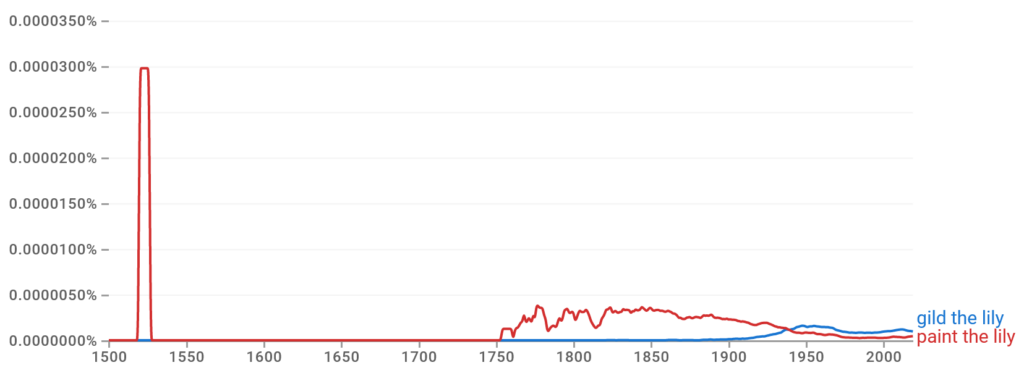Gild the lily means to embellish or enhance something already beautiful or perfect, often unnecessarily.
Idioms such as gild the lily are expressions or phrases with meanings that cannot be understood from the individual words. They often carry cultural or figurative significance, and their interpretation may differ from the literal meaning of the words used. They are popularly used in the English language to figuratively enhance or clarify a message.
In this guide, I delve into the deeper meaning of this idiomatic expression, explore its true origin, and discuss its proper usage in different contexts. I also provide tips for effectively wielding it in your material, along with sentence examples, variations, and related terms and phrases.
So keep reading to learn more about the idiom gild the lily, and put your newfound knowledge to the test with the quick quiz at the end. Let’s go!

What Does the Idiom Gild the Lily Mean?
The idiom gild the lily means to unnecessarily embellish or adorn something that is already beautiful or perfect, making it excessive or extravagant. The idiom alludes to the fact that the flower of a lily is already perfect and needs no superficial embellishment to enhance it.
Merriam-Webster defines gild the lily as “to add unnecessary ornamentation to something beautiful in its own right.” Moreover, the Cambridge Dictionary defines it as “to improve or decorate something that is already perfect and therefore spoil it.”
The idiom’s use often implies that the additional effort or adornment may not be required or may even detract from the original quality or appeal. For instance, I have never understood why so many women feel the need to layer on make-up. In my opinion, that is simply gilding the lily—creating unnecessary work and covering their natural beauty.
Gild the Lily or Paint the Lily: What’s the Difference?
The correct idiom is gild the lily, not paint the lily. It originates from a misquotation of a line from Shakespeare’s play King John, further explained in the section pertaining to origins below.
Paint the lily is a variation that is not widely recognized or used. It essentially conveys the same meaning as gild the lily when used, but we recommend sticking to gild the lily to avoid confusion.
Variations of Gild the Lily
While gild the lily is the commonly used form of the idiom, there are a few variations that convey a similar meaning. Here are some variations:
- Paint the lily
- Gild refined gold
- Gild the rose
- Gild the lily of the field
How Is the Idiom Gild the Lily Commonly Used in Context?
The idiom gild the lily finds its place in conversations where individuals discuss the act of adding unnecessary embellishments to something already beautiful or perfect.
In the following sections, explore the diverse applications of this idiom, discover real-world examples showcasing its use, and gain tips on employing it effectively.
What Are the Different Ways to Use the Idiom Gild the Lily?
- In design or aesthetics: The interior decorator disagreed with the decorative additions, exclaiming it would be gilding the lily and ruin the elegant look.
- In fashion or personal style: She wore excessive jewelry with her dress, which felt like gilding the lily and detracted from the elegance of the outfit.
- In marketing or advertising: The company introduced unneeded features to the product, gilding the lily and driving up the price, despite already meeting consumers’ needs.
- In writing or literature: The author continued to revise the novel, ultimately gilding the lily with unnecessary detail and making the story lose its original impact.
- In personal achievements or accomplishments: She received several awards for her work and felt further recognition would be gilding the lily and taking away from her existing achievements.
- In culinary or food presentation: The chef added excessive garnishes, gilding the lily and overshadowing the natural flavors of the entre.
- In speeches or public speaking: The speaker felt the need to include dramatic gestures, gilding the lily and distracting the audience from the main message.
Where Can You Find Examples of the Idiom Gild the Lily?
Examples of the idiom gild the lily can be found in various forms of media, including literature, journalism, film, and everyday conversations
Online news publications, gossip columns, and social media also often quote the idiom, like in these few examples:
Even accounting for a manager’s need to continually gild the lily, Strachan’s take on the campaign to date remains at odds with the consensus. (The Daily Mail)
Last Sunday, as I was hoarding mine, as if it might be lifted by a sweets thief, I spotted the baklava sundae, the epitome of gilding the lily, just as Louise and Andy Watson were headed that way. (The Telegraph)
What Are Some Tips for Using the Idiom Gild the Lily?
- Understand the meaning: Make sure you clearly understand the idiom’s meaning before using it.
- Context is key: Use the idiom in appropriate contexts where the concept of unnecessary adornment or enhancement fits. It is commonly used in design, aesthetics, fashion, marketing, or discussions of personal achievements.
- Be mindful of tone: Consider the tone and intention of your statement when using the idiom. It can convey a sense of criticism or highlight the importance of simplicity and natural beauty. Pay attention to the overall tone of the conversation or written piece.
- Use it sparingly: As with any idiom, using gild the lily excessively can diminish its impact. Reserve it for situations where the concept is truly applicable and adds value to your communication.
What Is the Origin of the Idiom Gild the Lily?

The expression gild the lily comes from a misquoting of Shakespeare. The actual line is “To gild refined gold, to paint the lily” from Shakespeare’s play King John, written in 1595.
This sentiment was misquoted in an allusion to this phrase by the Newark Daily Advocate in 1895, “One may gild the lily and paint the rose…” The more correctly rendered idiom paint the lily was a phrase used as often as the idiom gild the lily during the twentieth century, but the idiom paint the lily has now fallen by the wayside.
What Are Some Related Terms to the Idiom Gild the Lily?
To better place the idiom in context and to avoid its overuse, consider using related terms to help create clear and concise communication.

Synonyms for Gild the Lily
- Over-embellish
- Overdecorate
- Overdo
- Excessively adorn
- Overcomplicate
- Overdress
- Overembroider
- Overbeautify
Antonyms for Gild the Lily
These antonyms can be used to convey a different approach or perspective that emphasizes simplicity and restraint.
- Simplify
- Streamline
- Understate
- Minimize
- Downplay
- Unadorned
- Natural
Gilding the Lily: Test Your Knowledge!
Choose the correct answer.
What Have We Learned about the Idiom Gild the Lily?
The idiom gild the lily means to unnecessarily embellish or adorn something that is already beautiful or perfect. It implies the act of adding unnecessary or excessive decoration or enhancements to something already inherently attractive. The idiom serves as a reminder that sometimes simplicity and natural beauty are more appealing and valuable than attempting to improve upon perfection.
Originating from a misquoted Shakespearean play, the expression’s use has been well-established in the English language. It serves as a reminder to appreciate and embrace the inherent beauty and excellence in things as they are without the need for unnecessary embellishments.
Look for more idiomatic examples and explanations on our site! Learning about what specific idioms mean and how to use them will elevate your English language skills and prove concise communication!
Enjoyed reading about this idiom? Check out some others we covered:
